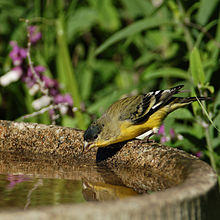Lesser goldfinch
| Lesser Goldfinch | |
|---|---|
 |
|
| Intermediate male Note mottled back and cap |
|
| Scientific classification | |
| Kingdom: | Animalia |
| Phylum: | Chordata |
| Class: | Aves |
| Order: | Passeriformes |
| Family: | Fringillidae |
| Genus: | Spinus |
| Species: | S. psaltria |
| Binomial name | |
|
Spinus psaltria (Say, 1823) |
|
| Subspecies | |
|
2-5, see text |
|
| Synonyms | |
|
Carduelis psaltria |
|
2-5, see text
Carduelis psaltria
Astragalinus psaltria
The Lesser Goldfinch (Spinus psaltria) is a very small songbird of the Americas. Together with its relatives the American Goldfinch and Lawrence's Goldfinch, it forms the American goldfinches clade in the genus Spinus sensu stricto.
The American goldfinches can be distinguished by the males having a black (rarely green) forehead, whereas the latter is (like the rest of the face) red or yellow in the European Goldfinch and its relatives. North American males are markedly polymorphic and 5 subspecies are often named; at least 2 of them seem to represent a less-progressed stage in evolution however.
This petite species is not only the smallest North American Spinus finch, it may be the smallest true finch in the world. Some sources list more subtropical Spinus species as slightly smaller on average, including the Andean siskin. This species ranges from 9 to 12 cm (3.5 to 4.7 in) in length and can weigh from 8 to 11.5 g (0.28 to 0.41 oz). Among standard measurements, the wing chord is 5.5 to 7 cm (2.2 to 2.8 in), the tail is 3.9 to 4.7 cm (1.5 to 1.9 in), the bill is 0.9 to 1.1 cm (0.35 to 0.43 in) and the tarsus is 1.1 to 1.2 cm (0.43 to 0.47 in). There is a slight NW-SE cline in size, with the largest birds from Mexico and south being up to one-fifth larger than the smallest from the extreme NW of its range; this effect is more pronounced in females. There is also considerable variation in the amount of black on head and back in males, and thus three subspecies have been proposed. But this variation too seem to be simple and clinal changes in allele frequency, and thus the "subspecies" might be better considered morphs or geographical forms.
...
Wikipedia

